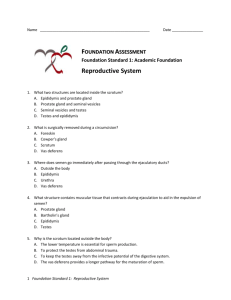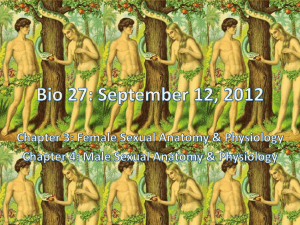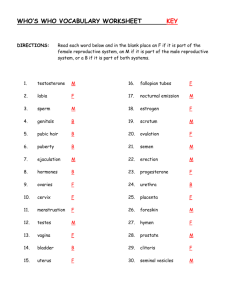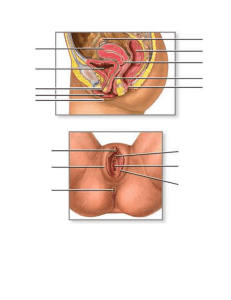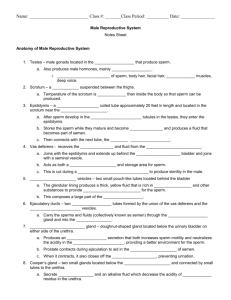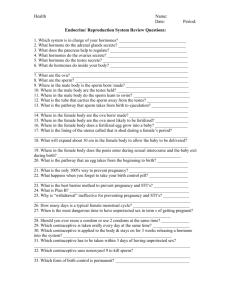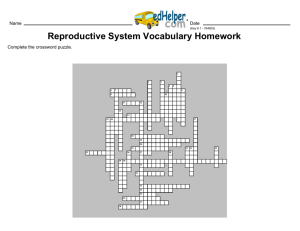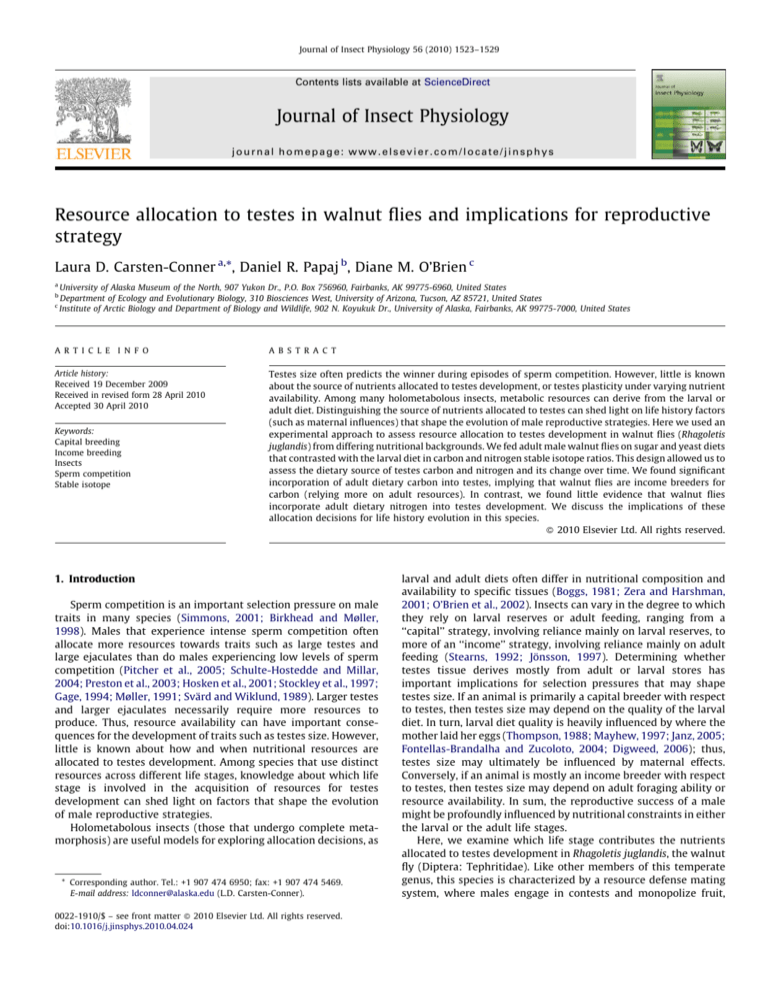
Journal of Insect Physiology 56 (2010) 1523–1529
Contents lists available at ScienceDirect
Journal of Insect Physiology
journal homepage: www.elsevier.com/locate/jinsphys
Resource allocation to testes in walnut flies and implications for reproductive
strategy
Laura D. Carsten-Conner a,*, Daniel R. Papaj b, Diane M. O’Brien c
a
University of Alaska Museum of the North, 907 Yukon Dr., P.O. Box 756960, Fairbanks, AK 99775-6960, United States
Department of Ecology and Evolutionary Biology, 310 Biosciences West, University of Arizona, Tucson, AZ 85721, United States
c
Institute of Arctic Biology and Department of Biology and Wildlife, 902 N. Koyukuk Dr., University of Alaska, Fairbanks, AK 99775-7000, United States
b
A R T I C L E I N F O
A B S T R A C T
Article history:
Received 19 December 2009
Received in revised form 28 April 2010
Accepted 30 April 2010
Testes size often predicts the winner during episodes of sperm competition. However, little is known
about the source of nutrients allocated to testes development, or testes plasticity under varying nutrient
availability. Among many holometabolous insects, metabolic resources can derive from the larval or
adult diet. Distinguishing the source of nutrients allocated to testes can shed light on life history factors
(such as maternal influences) that shape the evolution of male reproductive strategies. Here we used an
experimental approach to assess resource allocation to testes development in walnut flies (Rhagoletis
juglandis) from differing nutritional backgrounds. We fed adult male walnut flies on sugar and yeast diets
that contrasted with the larval diet in carbon and nitrogen stable isotope ratios. This design allowed us to
assess the dietary source of testes carbon and nitrogen and its change over time. We found significant
incorporation of adult dietary carbon into testes, implying that walnut flies are income breeders for
carbon (relying more on adult resources). In contrast, we found little evidence that walnut flies
incorporate adult dietary nitrogen into testes development. We discuss the implications of these
allocation decisions for life history evolution in this species.
ß 2010 Elsevier Ltd. All rights reserved.
Keywords:
Capital breeding
Income breeding
Insects
Sperm competition
Stable isotope
1. Introduction
Sperm competition is an important selection pressure on male
traits in many species (Simmons, 2001; Birkhead and Møller,
1998). Males that experience intense sperm competition often
allocate more resources towards traits such as large testes and
large ejaculates than do males experiencing low levels of sperm
competition (Pitcher et al., 2005; Schulte-Hostedde and Millar,
2004; Preston et al., 2003; Hosken et al., 2001; Stockley et al., 1997;
Gage, 1994; Møller, 1991; Svärd and Wiklund, 1989). Larger testes
and larger ejaculates necessarily require more resources to
produce. Thus, resource availability can have important consequences for the development of traits such as testes size. However,
little is known about how and when nutritional resources are
allocated to testes development. Among species that use distinct
resources across different life stages, knowledge about which life
stage is involved in the acquisition of resources for testes
development can shed light on factors that shape the evolution
of male reproductive strategies.
Holometabolous insects (those that undergo complete metamorphosis) are useful models for exploring allocation decisions, as
* Corresponding author. Tel.: +1 907 474 6950; fax: +1 907 474 5469.
E-mail address: ldconner@alaska.edu (L.D. Carsten-Conner).
0022-1910/$ – see front matter ß 2010 Elsevier Ltd. All rights reserved.
doi:10.1016/j.jinsphys.2010.04.024
larval and adult diets often differ in nutritional composition and
availability to specific tissues (Boggs, 1981; Zera and Harshman,
2001; O’Brien et al., 2002). Insects can vary in the degree to which
they rely on larval reserves or adult feeding, ranging from a
‘‘capital’’ strategy, involving reliance mainly on larval reserves, to
more of an ‘‘income’’ strategy, involving reliance mainly on adult
feeding (Stearns, 1992; Jönsson, 1997). Determining whether
testes tissue derives mostly from adult or larval stores has
important implications for selection pressures that may shape
testes size. If an animal is primarily a capital breeder with respect
to testes, then testes size may depend on the quality of the larval
diet. In turn, larval diet quality is heavily influenced by where the
mother laid her eggs (Thompson, 1988; Mayhew, 1997; Janz, 2005;
Fontellas-Brandalha and Zucoloto, 2004; Digweed, 2006); thus,
testes size may ultimately be influenced by maternal effects.
Conversely, if an animal is mostly an income breeder with respect
to testes, then testes size may depend on adult foraging ability or
resource availability. In sum, the reproductive success of a male
might be profoundly influenced by nutritional constraints in either
the larval or the adult life stages.
Here, we examine which life stage contributes the nutrients
allocated to testes development in Rhagoletis juglandis, the walnut
fly (Diptera: Tephritidae). Like other members of this temperate
genus, this species is characterized by a resource defense mating
system, where males engage in contests and monopolize fruit,
1524
L.D. Carsten-Conner et al. / Journal of Insect Physiology 56 (2010) 1523–1529
thereby gaining access to females who come to the fruit to oviposit
(Papaj, 1994). Both males and females mate multiply (Nufio et al.,
2000), and as in other polyandrous species (e.g. Gage, 1994,
Stockley et al., 1997), testes size is relatively large in proportion to
body size. There is also evidence that males adjust testes size in
relation to perceived levels of sperm competition (e.g., mean testis
area among males in a 1:11 M:F sex ratio treatment was 0.54 mm,
in contrast to a mean testis area of 0.60 mm among males in a
9:3 M:F sex ratio treatment; Carsten-Conner, Papaj, in preparation). Taken together, these factors suggest that allocation of
resources to testes could be an important component of overall
reproductive strategy for male walnut flies.
If allocating resources to testes is important for reproductive
success, one might expect that males would invest a large
proportion of both larval and adult resources to testes (testes
continue to grow until 11 days after eclosion in this species).
However, investment constraints might arise through nutritional
constraints imposed by diet quality. Walnut fly larvae solely
ingest their natal host fruit. Among walnut flies, a poor-quality
larval environment (small fruit size or increased larval density)
leads to small body size (Nufio and Papaj, 2004), illustrating that
overall resource availability is reduced under these conditions.
Thus, we predicted that small flies would experience more
investment constraints on capital reserves than would large flies,
leading to reliance on an income strategy for testes investment.
Adult flies are thought to obtain carbohydrates primarily from
fruit exudates and nitrogenous resources from ephemeral
sources such as bird feces (Prokopy and Papaj, 2000). There
are reasons to expect that small males will direct these income
resources to testes rather than other reproductive activities.
Large walnut flies outcompete small flies in contests (Papaj,
unpublished data), and small males gain fewer mates than do
large males (in paired mating trials, about 28% of small flies
gained mates compared to 74% of large flies; Carsten-Conner,
unpublished data). If a small male is unlikely to win contests
during pre-copulatory competition, it may be to his advantage to
invest maximally in testes in order to try to compete in the
postcopulatory arena. Large males, which eclose from pupation
with a reproductive advantage, may have less need to direct
income resources to testes, freeing up these resources for
allocation to other functions or traits. Here, we ask whether
small flies can compensate for their size by allocating relatively
more adult resources to testes than do large flies.
2. Methods
We tested our predictions by feeding adult walnut flies
isotopically contrasting diets, in order to determine the proportion
of testes carbon and nitrogen deriving from the larval vs. the adult
lifestage. In order to trace larval vs. adult sources of tissue carbon,
we took advantage of the naturally occurring 13C enrichment of C4
plants relative to C3 plants (O’Leary, 1988). The larval diet consists
of the fruit of a C3 plant, walnut (Juglans major). Adults in the lab
were maintained on cane sugar (a C4 plant) and yeast. We used two
alternate batches of yeast, grown under identical conditions on
cane sugar (C4) and beet sugar (C3), in order to distinguish yeastderived carbon from sugar-derived carbon. Thus, each group of
flies was grown on an isotopically unique combination of larval
and adult carbon sources. In order to trace larval vs. adult sources
of tissue nitrogen we differentially labeled the two yeast forms
using 15N labeled ammonium sulfate in the growth medium to
provide a contrast with walnut fruit 15N. The isotope signatures of
all dietary components are given in Table 1.
We used these isotopic differences to calculate the proportional
contribution of larval and adult sources of carbon and nitrogen to
testes. In order to evaluate whether allocation of larval vs. adult
Table 1
Experimentally determined values for carbon and nitrogen signatures of different
diet components. Data are given with standard deviations.
Source
d13C
d15N
Sugar cane
Walnut fruit
Enriched yeast
Unenriched yeast
11.96 0.09
25.65 0.47
10.12 0.04
23.95 0.05
N/A
1.46 2.23
252.54 1.58
3.78 0.05
resources to testes was different with respect to the rest of the fly,
we also estimated these values for thoraxes.
2.1. Experimental protocol
Flies were obtained from larval-infested fruit collected at sites
in southern Arizona during the summer of 2005. Infested fruit were
brought into the lab and held over sand until mature larvae
emerged and pupated in the sand. Pupae were placed into cups and
maintained at 4 8C for at least four months prior to the study, and
warmed to room temperature (ca. 29 8C). Adult flies eclosed
approximately 3 weeks after warming. Flies used in this study
originated from multiple fruits from multiple trees. Flies originating from a given collection cup were distributed evenly across
treatments. Within 48 h of eclosion, we aspirated male flies into 12
clear plastic 473-ml cups. We made visual estimates of body size
and placed 10 small flies into six of the cups, and 10 large flies into
the other six cups. We only used flies that appeared to lie on the
small and large ends of a continuum of body size—that is, mediumsize flies were avoided. We supplied the cups with an ad libitum
amount of one of two types of yeast: half the cups received yeast
enriched in 15N and the other half received unenriched yeast.
Details on the growth of these labeled and unlabeled yeasts are
given in O’Brien et al. (2008).
The flies were reared in an incubator kept at ca. 27 8C. One cup
containing small flies and one cup containing large flies were
collected and frozen at three different time intervals: 5, 10, and 15
days post eclosion. We also harvested 10 large and 10 small flies at
0 days post eclosion in order to obtain a baseline estimate for larval
reserves. This entire experiment was replicated three times.
For each cup in each replicate, we dissected out the testes of each
fly under a dissecting scope and placed all fly testes from a single cup
into a pre-weighed tin capsule. Samples were oven dried at 60 8C for
over 24 h, and dry mass was recorded. Pooling the testes in this
manner was necessary, as testes weight from a single fly was too
small to obtain an accurate isotopic analysis. We photographed
testes to estimate testes area. We also photographed the wings of
each fly in order to obtain an actual body size (post hoc to our visual
estimates), as mid-wing vein length correlates well with body mass
(H. Alonso-Pimentel, unpublished data). Mid-wing vein length and
testes area were calculated using ImageJ software (National
Institutes of Health, version 1.32j). For estimates of thorax allocation,
we used a subset of the animals in each cup for isotope analysis.
Because thorax weight greatly exceeded testes weight, all animals
from a cup could not be pooled into a single sample. Legs and wings
were removed from all thoraxes, and we randomly selected thoraxes
from each cup for analysis.
2.2. Determination of stable isotope ratios
The carbon and nitrogen isotope ratios of testes and thoraxes
were measured at the Alaska Stable Isotope Facility using
continuous flow isotope ratio mass spectrometry. The analytical
setup consisted of a Costech ECS4010 Elemental Analyzer
interfaced with a Finnigan Delta Plus XP isotope ratio mass
spectrometer via the Conflo III interface (Thermo-Finnigan, Inc.,
L.D. Carsten-Conner et al. / Journal of Insect Physiology 56 (2010) 1523–1529
Bremen). Data are expressed in delta notation as ((Rsample/
Rstandard) 1 1000). R is the ratio of heavy to light isotope (for
both carbon and nitrogen) and standards are Vienna PDB for
carbon and Air N for nitrogen. We obtained C/N ratios, d13C, and
d15N values. We concurrently weighed and ran multiple peptone
standards (d13C = 15.8, d15N = 7.0) to assess analytical accuracy
and precision; these gave values of d13C = 15.8 0.1% (SD), and
d15N = 7.0 0.2% (SD).
2.3. Calculations
The isotope ratio of nitrogen or carbon in tissue is a function of
the isotopic signatures of its nitrogen or carbon sources weighted
by their proportional contributions to the tissue. These values
might be offset by shifts in isotope ratio (fractionation) that occur
during assimilation and metabolism of nutrients (e.g. Spence and
Rosenheim, 2005).
Carbon in the testes or thorax could be derived from three
sources: walnut fruit in the larval stage (%C fruit), and both yeast (%C
yeast) and sugar (%C sugar) in the adult stage:
%Cyeast
%Cfruit
þ d13 Cyeast
d13 Ctissue ¼ d13 Cfruit
100%
100%
%C
sugar
þ d13 Csugar
þD
100%
100% ¼ %Cfruit þ %Cyeast þ %Csugar
where D describes the isotopic offset between diet and tissue. We
assume that the actual D value lies between 1% to +1%, which is
within the standard range for herbivorous insects (Spence and
Rosenheim, 2005), and we solve for D = 0, 1, and +1. D = 0 is
represented graphically.
We first calculated the percent C derived from yeast, and then
used that value to calculate the carbon contributions of fruit
(obtained at larval stage) and sugar (obtained at adult stage).
We calculated percent C derived from yeast as follows (O’Brien
et al., 2002):
%C from yeast ¼
d13 Clabeled
d13 Clabeled
d13 Cunlabeled tissue
100%
13
yeast d CCunlabeled yeast
tissue
We calculated the amount of nitrogen in the testes and thorax
derived from adult (yeast) sources by using the following equation:
15
%Nyeast ¼
15
d Nlabeled tissue d Nunlabeled
d15 Nlabeled yeast d15 Nunlabeled
tissue
100%
yeast
1525
a linear model to ask whether age or size predicted % adult or larval
nitrogen in testes and thorax.
We also compared C:N ratios in thorax and testes over time, and
used ANOVA to ask whether age, size, or age size predicted
overall % adult carbon and % adult nitrogen in the testes or thorax.
Finally, we calculated the total mass of carbon and nitrogen
invested in both testes and thorax in grams from all dietary sources
by multiplying tissue dry mass %C or %N divided by 100.
In order to confirm previous data indicating that testes grow
continuously until ca. 11 days in these flies (Carsten-Conner,
unpublished data), we used a linear model to ask whether testes
area was predicted by age and body size. We also fit testes size data
over time to a nonlinear model in order to determine if there were
differences in growth rate between small and large flies. We used
the turnover model described above to fit the testes growth data.
All statistical analyses were carried out using JMP-IN statistical
software (SAS Inc.; Cary, NC, version 5.1.2). Results are reported
with standard errors.
3. Results
3.1. Body size and testes growth
In this study, we visually categorized flies at eclosion as large vs.
small, and after flies were frozen, used mid-wing vein length to
quantify differences in body size. The mean mid-wing vein length
measurement for all flies was 1.4 0.01 mm. The mean vein length
of small vs. large flies was highly significantly different (mean SE
for small = 1.27 0.007 mm, mean SE for large = 1.56 0.006 mm;
t-test, t = 27.9, df = 347, p < 0.0001).
Measurements of testes area over time corroborated previous
results (Carsten-Conner unpublished data) that testes continue to
grow until approximately 11 days after eclosion (Fig. 1). We also
fitted nonlinear models to testes area over time to describe the
differences in testes growth rate between small and large flies
(Fig. 1). The results indicate that there were differences between
large and small flies in initial (0.24 0.01 vs. 0.37 0.01 mm2,
respectively) and final (0.34 0.01 vs. 0.49 0.01 mm2, respectively)
testes area, but not in growth rate (small r = 0.30 0.13, large
r = 0.21 0.06).
3.2. C:N ratios, total %C and % N
The mean C:N ratio for testes was 4.16 0.10%. This ratio did not
change over time. There were no differences between total % C or % N
where d15Nlabeled tissue is the isotopic ratio of nitrogen from males
fed labeled yeast, d15Nunlabeled tissue is the isotopic ratio of nitrogen
from males fed unlabeled yeast, and d15Nlabeled yeast and
d15Nunlabeled yeast are the actual isotopic ratios of the nitrogen in
the two yeasts. Because all other nitrogen must be derived from
larval sources, the percent nitrogen derived from walnut fruit was
simply = 100 %Nyeast.
We calculated the change in carbon in testes and thorax over
time using the following turnover model:
%CðdayÞ ¼ ð1 erday Þð%Cf %Ci Þ þ %Ci ;
where %Ci is the initial %C, Cf is the final %C, and r is the fractional
turnover rate (O’Brien et al., 2000, 2002, 2004; Min et al., 2006). We
used a nonlinear model to estimate r, Ci, and Cf. The value t50, time
to 50% of maximal turnover, was also calculated (t50 = ln(2)/r). We
fit this model to data on small and large flies separately, as well as
to the pooled data, and compared the fit between the pooled and
separate data to determine if there were differences in parameters
between small and large flies (Motulsky and Ransnas, 1987). The
nonlinear model was a poor fit for the nitrogen data; thus, we used
Fig. 1. Testes area increases over time, leveling off between 10 and 15 days of age.
These results corroborate earlier results that show testes stop growing at about 11
days of age. Fitting a nonlinear model to testes growth shows that there are
significant differences between small and large flies in terms of initial and final size,
but not in growth rate.
L.D. Carsten-Conner et al. / Journal of Insect Physiology 56 (2010) 1523–1529
1526
in testes by age, size, or age size. The mean C:N ratio for thoraxes
was 4.36 0.30%. In contrast to testes, the C:N ratio increased over
time, starting at 3.9 0.07% at day 0, and reaching 4.5 0.07% by day
5 (ANOVA, F3,71 = 12.78, p < 0.001). There were no differences in C:N
ratio between days 5, 10, or 15. The change in C:N ratio between days
0 and 5 appears to be caused by a statistically significant decrease in
nitrogen in the thorax, rather than an increase in carbon (mean N at
day 0 for large flies = 12.3%, mean N at day 5 = 11.18%; effects test
from ANOVA F3,67 = 9.86, p < 0.001). There were also significant
differences in overall % N in thorax by size (effects test from ANOVA
F3,67 = 10.8, p = 0.0016) and age size (effects test from ANOVA
F3,67 = 3.2, p = 0.03). Large flies had a higher percentage of nitrogen in
thorax overall compared to small flies, largely driven by a higher
percent of N at day 0 for large flies (12.9%), after which nitrogen level
drops in large flies. This indicates that large, but not small flies, lose
some amount of nitrogen from the thorax after eclosion that is not
replaced. However, thorax weight remained constant over time.
3.3. Allocation of carbon to testes and thorax
The amount of carbon contributed to testes and thorax from
yeast was not distinguishable from zero; thus, we calculated
contributions from larval and adult sources by the following
equation:
%C from fruit ¼
ðd13 Ctissue DÞ d13 Csugar
100%;
d13 Cfruit d13 Csugar
where d13Ctissue is the isotopic ratio for carbon from males, d13Csugar
is the isotopic ratio of sugar carbon, d13C fruit is the isotopic ratio for
walnut fruit, and D gives the isotopic offset between diet and
tissue, tested at three levels: 1%, 0%, and +1%). All signatures
from labeled and unlabeled flies are reported in Table 2.
Carbon turned over rapidly in testes, with carbon from adult
sugar constituting 52% of all testes C by day 5 (Fig. 2). Replacement
of larval carbon continued at a slower rate until day 10. Day 15 was
no different than day 10 for % adult dietary carbon in testes.
Because testes grow until approximately 11 days after eclosion,
this pattern indicates that adult carbon is important in testes
growth, but that carbon turnover largely stops once testes have
reached maximal size. Adult carbon contribution to testes plateaus
at about 68%; this value assumes a fractionation of 0%. If we
assume a fractionation of 1% (Spence and Rosenheim, 2005), the
percent of carbon from adult sugar in testes at plateau ranges from
61% to 75%. From the range of values, it is clear that flies incorporate a
large amount of carbon from adult diet into their testes.
The turnover model yielded a fractional turnover rate of
0.28 1.84 for adult carbon vs. time, and 0.28 0.03 for larval carbon
Fig. 2. Testes carbon turns over rapidly in testes with adult dietary sugar. All initial
carbon derives from larval sources, but carbon from adult sugar constitutes 52% of
all testes C by day 5, and reaches a plateau above 60% between days 10 and 15. There
was no detectable incorporation of carbon from adult dietary yeast, and there were
no differences between small and large flies in testes carbon turnover.
over time. This translates into a half-life (time to 50% of maximal
turnover) of 2.5 days. Although age significantly predicted carbon
turnover, there were no differences in carbon turnover rate by size.
The nonlinear model fitting carbon turnover by age and size fit the
pooled data better than the separate data (Extra sum of squares test,
F3,17 = 0.133, p = 0.93).
Carbon turned over to a lesser degree in thorax than in testes,
and there were differences between large and small flies. Carbon
from adult sugar constituted only 32% of all thorax C by day 5 for
large flies, and 41% for small flies (Fig. 3). Replacement of larval
carbon continued at a slower rate until day 15 for both sizes, when
carbon from adult sugar reached 41% of all thorax C for large flies,
and 48% for small flies. Again, these values assume a fractionation
of 0%. If fractionation was +1%, day 15 values would be 48% for
large flies and 59% for small flies. Assuming a fractionation of 1%
shifts these values to 34% for large flies, and 40% for small flies.
Thus, while differing estimates of carbon isotope fractionation
alter absolute values of carbon incorporation, the difference
between large and small flies remains constant.
In contrast to testes, there were differences in fractional carbon
turnover rates by size (nonlinear model results: F3,34 = 5.66,
p = 0.003), with small flies turning over carbon more rapidly than
large flies (small r = 0.43 0.06, large r = 0.28 0.07 for adult
Table 2
Isotopic signatures of tissues in this study. Data are expressed in delta notation as
((Rsample/Rstandard) 1) 1000. R is the ratio of heavy to light isotope (for both
carbon and nitrogen) and standards are Vienna PDB for carbon and Atmospheric N
for nitrogen. L = labeled yeast, U = unlabeled yeast. Data are given with standard
errors.
Yeast
Nitrogen (d15N)
Age (days)
0
5
10
15
Testes
L
7.61 0.82
8.12 1.17
23.07 4.0
Carbon (d13C)
U
L
U
6.7 0.32
5.63 0.53
5.78 0.25
4.98 0.39
18.46 0.41
17.75 0.32
16.40 0.2
23.54 0.16
18.49 0.32
17.09 0.29
16.28 0.22
7.83 0.24
7.37 0.36
8.64 0.44
8.43 0.29
20.54 0.19
20.07 0.17
19.85 0.18
23.86 0.18
20.63 0.29
19.96 0.21
19.58 0.24
Thorax
0
5
10
15
10.22 0.68
10.14 0.95
15.24 2.56
Fig. 3. Thorax carbon turns over with adult dietary sugar less rapidly than does
testes carbon. There was no detectable incorporation of carbon from adult dietary
yeast. There were differences in thorax carbon turnover rates between small and
large flies. All initial carbon derives from larval sources, but carbon from adult sugar
constitutes 32% of all thorax C by day 5 for large flies, and 41% for small flies.
Replacement of larval carbon plateaus at 41% of all thorax C for large flies, and 48%
for small flies.
L.D. Carsten-Conner et al. / Journal of Insect Physiology 56 (2010) 1523–1529
1527
Table 4
Age and size significantly predict % adult nitrogen in thorax over time, while
age size does not (ANOVA).
Effect
SS
df
F
p-value
Size
Age
Size age
26.04
26.82
9.7
1,36
1,36
1,36
6.63
6.83
0.81
0.01
0.01
0.12
Fig. 4. There is very little replacement of larval nitrogen with adult sources in testes
tissue. Replacement is no different from zero until day 15, when nitrogen from yeast
ingested at the adult stage reaches 7% of all testes nitrogen. There are no differences
between small and large flies for testes nitrogen.
carbon). This translates into a half-life (time to 50% of maximal
turnover) of 1.6 days for small flies, and 2.5 for large flies.
3.4. Allocation of nitrogen to testes and thorax
In contrast to carbon, flies used little adult nitrogen in testes
(Fig. 4). Nitrogen contribution to testes from yeast was not
significantly different from zero until day 15, when the % adult
nitrogen in testes rose to 7% of overall testes nitrogen. The data
were poorly fit by an exponential turnover model; thus, we used a
linear model to predict whether age, size, or age size affected %
adult nitrogen in testes. Although there was an effect of age on
testes nitrogen from adult diet, as described above, there was no
effect of size and no interaction between age and size (Table 3).
As with testes, flies used little adult nitrogen overall in thorax
tissue. The linear model asking whether size, age, or age size
predicts nitrogen contribution to thorax showed that age is
significant in predicting % adult nitrogen in thorax (effects test
from ANOVA F1,36 = 2.78, p = 0.057). While age is a significant
predictor, contribution from adult yeast to thorax rose to only 2.6%
by day 15 (Fig. 5). There was also an effect of size, but not
age size, on adult nitrogen contribution to thorax (Table 4). Small
Table 3
Age significantly predicts % adult nitrogen in testes over time, while size and
age size do not (ANOVA).
Effect
SS
df
F
p-value
Size
Age
Size age
8.95
142.23
4.97
1,19
1,19
1,19
1.35
21.43
0.75
0.26
0.0002
0.40
Fig. 5. There is very little replacement of larval nitrogen from adult dietary sources
in thorax tissue. Replacement is close to zero until day 15, when nitrogen from yeast
ingested at the adult stage reaches 2.6% of all testes nitrogen (small and large flies
pooled).
Fig. 6. The amount of nitrogen in thorax tissue was different between small and
large flies over time. Note that the y axis in this figure reaches to only 6%; the figure
is blown up in order to view differences between large and small flies.
flies averaged 2.16 0.45% adult nitrogen in thorax, while large flies
averaged 0.43 0.43% (Fig. 6).
3.5. Relative allocation to each tissue
We compared relative allocation of resources to testes vs.
thorax for large vs. small flies by comparing the ratio of adult to
larval investment (in grams C or N) in each structure for each size
class. Small flies allocate more total adult carbon to thorax, and less
total adult carbon to testes than do large flies (Fig. 7). There were
no differences in adult: larval nitrogen (g) allocated to testes vs.
thorax for small vs. large flies.
4. Discussion
4.1. Overall allocation strategy
Walnut flies appear to be income breeders with respect to
carbon. Testes carbon turned over rapidly, reaching a final
Fig. 7. Ratio of adult: larval grams of carbon invested in testes vs. thorax differs for
small and large flies. Small flies invest relatively more grams of carbon from adult
dietary resources into thorax, and less into testes, than do large flies.
1528
L.D. Carsten-Conner et al. / Journal of Insect Physiology 56 (2010) 1523–1529
concentration of around 65% carbon from adult sugar in testes
tissue. Similarly, thorax tissue turned over to a final concentration
of over 40% carbon from adult sugar. This finding supports previous
results (e.g., Droney, 1998, Carsten-Conner unpublished data), that
dietary quality in the adult stage affects male testes development
among dipterans and points to dietary carbon as a key resource.
Because dipterans primarily use sugars to fuel energy metabolism
and flight (Candy, 1989), expensive contest behaviors in males are
likely to require income carbon for energy metabolism (Marden
and Waage, 1990; Parker and Thompson, 1980). Our finding that
male testes development also uses income carbon is consistent
with a reliance on adult dietary sugar sources (such as fruit
exudates, the suspected adult carbon source for Rhagoletis) for
male reproductive behavior and development overall, and underscores how life history strategy can be linked to nutrient
availability across an animal’s life stages.
The relatively low carbon to nitrogen ratio in testes found in this
study (see, e.g. Robbins et al., 2005 for various C:N ratios) indicates
that testes growth is a nitrogen-demanding process, yet flies
showed relatively little contribution of nitrogen from adult dietary
yeast to testes growth. The low incorporation of nitrogen from
adult dietary sources into testes and thorax indicates that under
the conditions of the present study, male walnut flies are capital,
rather than income, breeders with respect to nitrogen. This finding
begs the question of whether low reliance on dietary nitrogen
sources is typical of this species in nature, or whether the finding
might be an artifact of the nitrogen source provided in this study
(whole yeast). In a previous study, Drosophila melanogaster readily
incorporated nutrients from this experimental yeast into tissues
(O’Brien et al., 2008); however, Drosophila has a very different
nutritional ecology than Rhagoletis jugulandis and may be more
poised to take advantage of yeast and other microorganisms as
food sources. In a follow-up experiment we found that some
females achieved full reproductive development on our experimental yeast (which requires a dietary source of protein, Prokopy
and Papaj, 2000) while others did not (unpublished data). This
suggests that Rhagoletis flies are capable of ingesting the
experimental yeast, but the males nonetheless incorporated very
little into their testes.
While relatively little is known about adult feeding strategies
for walnut flies, flies in the genus Rhagoletis are thought to obtain
nitrogen primarily from bird feces deposited on foliage (Prokopy
and Papaj, 2000). These resources are likely to be ephemeral and
thus perhaps only opportunistically used, in contrast to walnut
fruit exudates (suspected carbon source), which are widely
available. Thus, the strategy of high reliance on income carbon,
but low reliance on income nitrogen, may reflect true conditions in
nature. More information about the relative amounts of carbohydrate-rich vs. protein-rich food sources ingested in nature would
help reveal how these elements are functionally used. For instance,
the flies may be using a strategy of constrained intake with
nutrient interconversion, or they may be using foraging strategies
that lead to a balanced intake of nutritionally complementary
foods (see Raubenheimer et al., 2009 for a discussion of the
geometric model of nutritional ecology).
4.2. Implications for the evolution of male reproductive strategies
We initially predicted that small flies should rely more on an
income strategy than large flies with respect to testes investment.
Large flies are at a distinct reproductive advantage in terms of
absolute testes size, ability to gain mates, and ability to win contests;
thus, we predicted that small flies might attempt to compensate for
their disadvantages by using more of their adult resources towards
testes growth than would large flies. Such a strategy might increase
chances of success in the postcopulatory arena. Contrary to this
prediction, there were no differences in carbon or nitrogen turnover
(larval to adult) in testes tissue between small and large flies. We
also found that small flies allocate relatively more adult carbon to
thorax, and less to testes than do large flies. It may be that nitrogen
limitation, particularly in flies with poorer larval nutrition, limits the
extent of testes development in the adult stage and hence of carbon
use in testes. Alternatively, if small flies engage in more energydemanding behaviors (e.g., flight, contests, etc.), they may require
more resource investment in flight muscle maintenance and repair
(O’Brien et al., 2008).
Taken together, our results suggest that ultimately, despite
their ability to use income resources towards testes growth, testes
size in walnut flies is largely determined by larval environment. To
the extent that increased testes size translates into a postcopulatory advantage as it does in other species (e.g. Stockley and Purvis,
1993; Pitnick and Markow, 1994; Schärer et al., 2004), larval
nutrition is likely to be an important determinant of sperm
competitive ability in males. Thus, testes size may ultimately
depend more on maternal oviposition decisions than on adult
foraging success or resource environment. Mothers that lay their
eggs in larger fruit will have larger offspring with larger testes, and
small flies do not appear to be capable of compensating for this
size-imposed disadvantage. Nufio and Papaj (2004) found that
females prefer to oviposit in large fruit, which has an overall
positive effect on larval size and fecundity. However, females also
have a strong preference to reuse hosts, which generates larval
competition and has an overall negative effect on size and
fecundity. Nufio and Papaj interpreted this to mean that there is
direct selection on females to reduce oviposition-related costs and
maximize number, rather than quality, of offspring. The present
results suggest that an oviposition decision that results in
decreased offspring size may also be detrimental to offspring
sperm competitive ability; which may increase selection pressure
for production of high-quality (e.g. large) offspring.
Acknowledgements
We thank Tim Howe and Norma Haubenstock at the Alaska
Stable Isotope Facility for analytical assistance, Kyung-Jin Min and
Marc Tatar for contributing the yeast used in this study, and
Heather Mallory, Brad Worden, Emilie Snell-Rood and Jeremy
Davis for assisting with fly collection and maintenance.
References
Birkhead, T.R., Møller, A.P., 1998. Sperm Competition and Sexual Selection. Academic Press, San Diego.
Boggs, C.L., 1981. Nutritional and life-history determinants of resource allocation in
holometabolous insects. American Naturalist 117, 692–709.
Candy, D.J., 1989. Utilization of fuels by the flight muscles. In: Goldsworthy, G.J.,
Wheeler, C.H. (Eds.), Insect Flight. CRC Press, Boca Raton, pp. 305–319.
Digweed, S.C., 2006. Oviposition preference and larval performance in the exotic
birch-leafmining sawfly Profenusa thomsoni. Entomologia Experimentalis et
Applicata 120, 41–49.
Droney, D.C., 1998. The influence of nutritional content of the adult male diet on
testis mass, body condition, and courtship vigor in a Hawaiian Drosophila.
Functional Ecology 12, 920–928.
Fontellas-Brandalha, T.M.L., Zucoloto, F.S., 2004. Selection of oviposition sites by
wild Anastrepha obliqua (Macquart) (Diptera: Tephritidae) based on the nutritional composition. Neotropical Entomology 33, 557–562.
Gage, M.J.G., 1994. Associations between body size, mating pattern, testis size and
sperm lengths across butterflies. Proceedings of the Royal Society of London
Series B: Biological Sciences 258, 247–254.
Hosken, D.J., Garner, T.W.J., Ward, P.I., 2001. Sexual conflict selects for male and
female reproductive characters. Current Biology 11, 489–493.
Janz, N., 2005. The relationship between habitat selection and preference for adult
and larval food resources in the polyphagous butterfly Vanessa cardui (Lepidoptera: Nymphalidae). Journal of Insect Behavior 18, 767–780.
Jönsson, K., 1997. Capital and income breeding as alternative tactics of resource use
in reproduction. Oikos 78, 57–77.
Marden, J.M., Waage, J.K., 1990. Escalated damselfly territorial contests are energetic wars of attrition. Animal Behavior 39, 954–959.
L.D. Carsten-Conner et al. / Journal of Insect Physiology 56 (2010) 1523–1529
Mayhew, P.J., 1997. Adaptive patterns of hostplant selection by phytophagous
insects. Oikos 79, 417–428.
Min, K.J., Hogan, M.F., Tatar, M., O’Brien, D.M., 2006. Resource allocation to reproduction and soma in Drosophila: a stable isotope analysis of carbon from dietary
sugar. Journal of Insect Physiology 52, 763–770.
Møller, A.P., 1991. Sperm competition, sperm depletion, paternal care, and relative
testis size in birds. American Naturalist 137, 882–906.
Motulsky, H.J., Ransnas, L.A., 1987. Fitting curves to data using nonlinear regression:
a practical and nonmathematical review. Federation of American Societies for
Experimental Biology (FASEB) Journal 1, 365–374.
Nufio, C.R., Papaj, D.R., 2004. Superparasitism of larval hosts by the walnut fly,
Rhagoletis juglandis, and its implications for female and offspring performance.
Oecologia 141, 460–467.
Nufio, C.R., Papaj, D.R., Alonso-Pimentel, H., 2000. Host utilization by the walnut fly,
Rhagoletis juglandis (Diptera: Tephritidae). Environmental Entomology 29, 994–
1001.
O’Brien, D.M., Boggs, C.L., Fogel, M.L., 2004. Making eggs from nectar: the role of life
history and dietary carbon turnover in butterfly reproductive resource allocation. Oikos 105, 279–291.
O’Brien, D.M., Fogel, M., Boggs, C.L., 2002. Renewable and nonrenewable resources:
amino acid turnover and allocation to reproduction in Lepidoptera. Proceedings
of the National Academy of Sciences of the United States of America 99, 4413–
4418.
O’Brien, D.M., Min, K.J., Tatar, M., 2008. Use of stable isotopes to examine how
dietary restriction extends Drosophila lifespan. Current Biology 18, R155–R156.
O’Brien, D.M., Schrag, D.P., del Rio, C.M., 2000. Allocation to reproduction in a
hawkmoth: a quantitative analysis using stable carbon isotopes. Ecology 81,
2822–2831.
O’Leary, M.H., 1988. Carbon isotopes in photosynthesis. Bioscience 38, 328–336.
Papaj, D.R., 1994. Oviposition site guarding by male walnut flies and its possible
consequences for mating success. Behavioral Ecology and Sociobiology 34,
187–195.
Parker, G.A., Thompson, E.A., 1980. Dung fly struggles: a test of the war of attrition.
Behavioral Ecology and Sociobiology 7, 37–44.
Pitcher, T.E., Dunn, P.O., Whittingham, L.A., 2005. Sperm competition and the
evolution of testes size in birds. Journal of Evolutionary Biology 18, 557–567.
Pitnick, S., Markow, T.A., 1994. Male gametic strategies: sperm size, testes size, and
allocation of ejaculate among successive mates by the sperm-limited fly
Drosophila pachea and its relatives. American Naturalist 143, 785–819.
1529
Preston, B.T., Stevenson, I.R., Pemberton, J.M., Coltman, D.W., Wilson, K., 2003. Overt
and covert competition in a promiscuous mammal: the importance of weaponry and testes size to male reproductive success. Proceedings of the Royal
Society of London Series B 270, 633–640.
Prokopy, R.J., Papaj, D.R., 2000. Behavior of flies of the genera Rhagoletis, Zonosemata,
and Carpomya. In: Aluja, M., Norrbom, A.L. (Eds.), Fruit Flies (Tephritidae):
Phylogeny and Evolution of Behavior. pp. 219–252.
Raubenheimer, D., Simpson, S.J., Mayntz, D., 2009. Nutrition, ecology and nutritional
ecology: toward an integrated framework. Functional Ecology 23, 4–16.
Robbins, C.T., Felicetti, L.A., Sponheimer, M., 2005. The effect of dietary protein
quality on nitrogen isotope discrimination in mammals and birds. Oecologia
144, 534–540.
Schärer, L., Ladurner, P., Rieger, R.M., 2004. Bigger testes do work more: experimental evidence that testis size reflects testicular cell proliferation activity in
the marine invertebrate, the free-living flatworm Macrostomum sp. Behavioral
Ecology & Sociobiology 56, 420–425.
Schulte-Hostedde, A.I., Millar, J.S., 2004. Intraspecific variation of testis size and
sperm length in the yellow-pine chipmunk (Tamias amoenus): implications for
sperm competition and reproductive success. Behavioral Ecology & Sociobiology 55, 272–277.
Simmons, L.W., 2001. Sperm Competition and its Evolutionary Consequences in the
Insects. Princeton University Press, Princeton.
Spence, K.O., Rosenheim, J.A., 2005. Isotopic enrichment in herbivorous insects: a
comparative field-based study of variation. Oecologia 146, 89–97.
Stearns, S.C., 1992. The Evolution of Life Histories. Oxford University Press, Oxford.
Stockley, P., Purvis, A., 1993. Sperm competition in mammals: a comparative study
of male roles and relative investment in sperm production. Functional Ecology
7, 560–570.
Stockley, P., Gage, M.J.G., Parker, G.A., Moller, A.P., 1997. Sperm competition in
fishes: the evolution of testis size and ejaculate characteristics. American
Naturalist 149, 933–954.
Svärd, L., Wiklund, C., 1989. Mass and production rate of ejaculates in relation to
monandry/polyandry in butterflies. Behavioral Ecology & Sociobiology 24, 395–
402.
Thompson, J.N., 1988. Evolutionary ecology of the relationship between oviposition
preference and performance of offspring in phytophagous insects. Entomologia
Experimentalis et Applicata 47, 3–14.
Zera, A.J., Harshman, L.G., 2001. The physiology of life history trade-offs in animals.
Annual Review of Ecology and Systematics 32 pp. 95–12.



